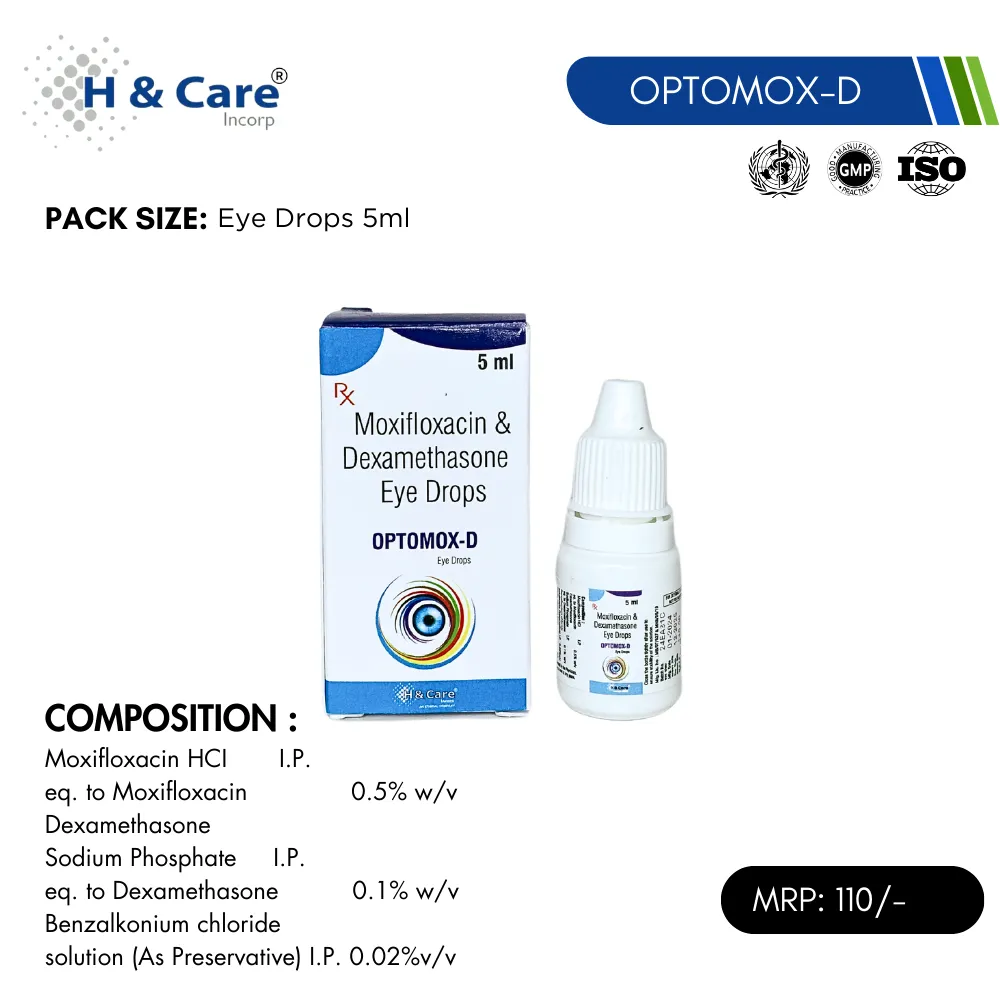
OPTOMOX EYE DROPS

OROLYTE ORS SACHET
OPTOMOX-D EYE DROPS for Eye Flu Treatment
MOXIFLOXACIN 0.5% W/V + DEXAMETHASONE. Optomox-D Eye Drops for Eye Flu Treatment.
Optomox-D eye drops, a combination of Moxifloxacin and Dexamethasone, provides an effective treatment in eye flu. By curing both the infection and the inflammation, this combination offers faster relief from symptoms.
Eye flu, also known as conjunctivitis, is a common infection that affects the outer eyes and the inner surface of the eyelids. It is characterized by redness, itching, tearing and discharge from the eyes. While most cases of eye flu are viral in nature and resolve on their own within a week or two, some cases may require treatment to prevent further complications.
When it comes to eye flu treatment, there are several options available. These include artificial tears, antihistamine eye drops and antibiotic eye drops. In recent years, the combination of Moxifloxacin and Dexamethasone has emerged as a highly effective eye flu treatment.
Moxifloxacin is a broad-spectrum antibiotic that belongs to the fluoroquinolone class. It works by inhibiting the growth of bacteria that commonly cause eye infections. Dexamethasone, on the other hand, is a corticosteroid that reduces inflammation and suppresses the immune response. When used together, Moxifloxacin and Dexamethasone target both the bacterial infection and the associated inflammation, providing a complete eye flu treatment.
Mechanism of Action of Moxifloxacin and Dexamethasone
Moxifloxacin works by inhibiting the enzyme DNA gyrase, which is essential for the replication and repair of bacterial DNA. By disrupting this process, Moxifloxacin prevents the bacteria from multiplying and spreading. This effectively stops the infection from progressing and allows the body’s immune system to clear the remaining bacteria.
Dexamethasone, on the other hand, works by binding to specific receptors in the cells and regulating the expression of genes involved in inflammation. It suppresses the release of inflammatory mediators, such as cytokines and prostaglandins, thereby reducing redness, swelling and discomfort in the eye.
The combination of Moxifloxacin and Dexamethasone provides a synergistic effect, with Moxifloxacin targeting the bacteria and Dexamethasone addressing the inflammation. This dual action ensures a faster resolution of symptoms and a reduced risk of complications.
Clinical Studies on the Efficacy of Moxifloxacin and Dexamethasone in Eye Flu Treatment
Studies have shown the effectiveness of this combination therapy compared to other treatment options.
In a randomized controlled trial with patients having bacterial conjunctivitis, the use of Moxifloxacin and Dexamethasone eye drops resulted in a significantly faster cure compared to other antibiotic eye drops alone. The combination therapy also showed a higher rate of bacterial eradication.
Another study compared the efficacy of Moxifloxacin and Dexamethasone eye drops with artificial tears in patients with viral conjunctivitis. The results showed that the combination therapy not only provided relief from symptoms but also reduced the duration of the infection. This suggests that Moxifloxacin and Dexamethasone may have antiviral properties in addition to their antibacterial and anti-inflammatory effects.
Side Effects of Using Moxifloxacin and Dexamethasone
While Moxifloxacin and Dexamethasone are generally safe and well-tolerated, there are some side effects and precautions to be aware of. Common side effects of Moxifloxacin eye drops include mild burning or stinging upon instillation, blurred vision and a temporary increase in eye irritation.
It is important to follow the prescribed dosage and duration of treatment to minimize the risk of side effects. If any adverse reactions occur, such as severe eye pain, vision changes or worsening symptoms, it is important to seek immediate medical attention.
When comparing Moxifloxacin and Dexamethasone with other treatment options for eye flu, several factors come into play. Antibiotic eye drops, such as Moxifloxacin, are effective against bacterial infections but have no effect on viral or allergic conjunctivitis. On the other hand, antihistamine eye drops can provide relief from itching and redness associated with allergic conjunctivitis but are not effective against bacterial or viral infections.
Optomox-D eye drops, the combination of Moxifloxacin and Dexamethasone, offers a unique advantage by addressing both bacterial infection and inflammation. This makes it a suitable treatment option for cases where the cause of eye flu is unknown or when there is a possibility of a mixed infection.
When considering the use of Moxifloxacin and Dexamethasone for eye flu treatment, it is important to consult a doctor. They can assess the severity of the infection, identify the underlying cause and determine the most appropriate treatment approach.
It is also important to follow the prescribed dosage and frequency of administration to ensure optimal efficacy. Treatment should be continued for the full duration recommended by the doctor, even if symptoms improve before completion.



Reviews
There are no reviews yet.